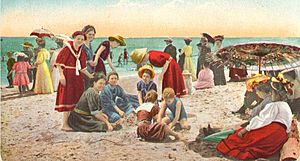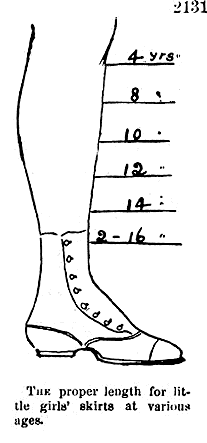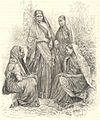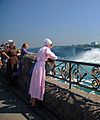Modesty facts for kids
Modesty (also called demureness or reticence) is the name for a number of norms of behaviour a society expects form the individual people that make up this society. Excessive modesty is sometimes called prudery.
Modesty usually includes:
- Avoiding attracting attention, by behaving the same way as everybody else, or as society expects.
- Using clothing that generally follows the same norms.
- Avoiding boasting with one's own accomplishments (this is known as humility)
Different fashions test the level of modesty. People are usually also subjected to peer pressure.
Different levels of modesty apply in different situations, and to different groups of people.
Contents
Modesty does not apply in an emergency situation
Modesty is a social norm, it does not apply when it cannot, such as in an emergency. In the case of an emergency it is more important that doctors treat those that are wounded.
Some people still insist on maintaining their standards of modesty, even in an emergency situation.
Different levels of modesty for different groups of people
Modesty usually says that the parts of the human body that do not need to be exposed should not be. Usually, this applies to bare skin, hair, undergarments, and especially to intimate parts. Sometimes, the standards do not only say that the respective part should be hidden, but also that special clothing should hide its shape, what it looks like. Certain standards say how the changing of clothes should be done, like using a towel on a beach or closing (and locking) a door of a cabin that is provided.
Different cultures have different standards of modesty. But standards are also different according to who the other people are, that could possibly see one's body:
- A spouse or partner
- A friend or family member of the same gender
- Family members of the opposite gender.
- A friend of the opposite gender.
Social standing or class can also matter. That way, different rules can apply to people of the same social class than to those of other (or lower) social classes.
Other things that influence these norms include:
- The place where it happens (undressing at home in front of a partner is different form undressing at the home of somebody barely known)
That way, a teacher that would perform at a night club might be seen as bringing the profession into disresapect. Some people say this kind of modesty is body shame.
Too much modesty is called prudishness. As a medical condition it is also called gymnophobia. Excessive immodesty is called exhibitionism.
What religious communities think
Islam
Islamic society thinks modesty is important, but there are different interpretations of what dress should be considered modest. Many Muslim women wear a headscarf (hijab) as a sign of modesty. More conservative societies expect that women cover their whole body, except for their hands and their face.
A woman who choses to also cover her face and hands is said to be expressing greater "modesty and holiness". In some Islamic societies, women wear the niqab, an all-encompassing garment intended to conceal every part of the body, sometimes including the eyes. Wearing a niqab (sometimes referred to as a burqa, although this term only technically applies to an Afghan all-in-one garment) is common in some countries with a majority Muslim population.
In most Muslim countries a woman can chose how to express her modesty. More conservative countries such as Afghanistan or Iran do have laws that say what kind of dress a woman should wear. Not obeying these laws can lead to harsh punishments.
Likewise, according to some Islamic interpretations of Hadith, men are required to cover everything from 'navel to knee'; with some men choosing to extend this to the traditional Islamic head covering taqiyah (cap), the male counterpart to hijab which closely resembles the Jewish yarmulke but is slightly larger in size. The taqiyah cap may vary in shape, size or color just as the hijab does, with many regional differences according to tradition and personal taste.
A burqini is a swimsuit designed for Muslim women that covers the whole body except the face, the hands and the feet, that enables them to satisfy the requirements of Muslim standards of modesty while enabling them to take part in swimming activities.
Judaism
Modesty is also important in Judaism, especially in the case of women. An ultra-orthodox Hasidic married woman is expected by their community to cover her hair in public, and sometimes at home. The hair covering may be a scarf, hat, snood, or a wig ("sheitel"). Some communities have stricter standards and expect women to cover their elbows and legs, with blouses covering the collarbone and sleeves covering elbows. Skirts are expected to cover the knees. All slits in skirts are expected to be closed. See-through materials may not be used and clothes are expected not to be tight-fitting, provocative, loud in color, or display texts. Some communities apply these standards to girls as young as three. Modern Orthodox women will usually wear a kerchief or a hat to cover the top of their head, exposing lower hair.
Non-orthodox Jewish women tend to adopt the fashions of the non-Jewish society in which they live.
Catholic Christianity
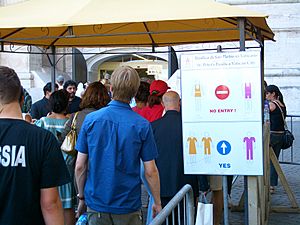
Catholics are expected to dress modestly, but there are no "official guidelines". Form time to time, priests and popes have given their opinion. These opinions are not binding, nevertheless many Catholics find them useful.
Pope Pius XII stated that women should cover their upper arms and shoulders, that their skirts should cover at least as far as the knee, and the neckline should not reveal anything. Another example is Giuseppe Cardinal Siri of Genoa, who stated that trousers were unacceptable dress for women. Many tradition-minded Catholics have attempted to further expand on this latter standard.
Some Catholics have attempted to make theories of modesty. Sometimes this is from a sociological perspective, while at other times it takes a more systematic, Thomistic approach, combined with the writings of the Church Fathers. Approaches arguing primarily from traditional practices and traditional authorities, such as the saints, can also be found.
The Church also expects men to dress modestly.
Images for kids
-
Three Ukrainian men, wearing trunks and briefs, attract attention for immodesty relative to the local norm in Cox's Bazar, Bangladesh
-
Modesty in dress is a relative cultural concept, even in the West, as seen above in the plain dress of Amish women on an American beach in 2007.
-
Modesty in dress for Buddhist monks visiting the Hindu-Buddhist temple complex Angkor Wat, Cambodia
-
An engraving of Christian women in India (1869)
-
An Anabaptist Christian lady wearing a cape dress and headcovering
See also
 In Spanish: Pudor para niños
In Spanish: Pudor para niños


